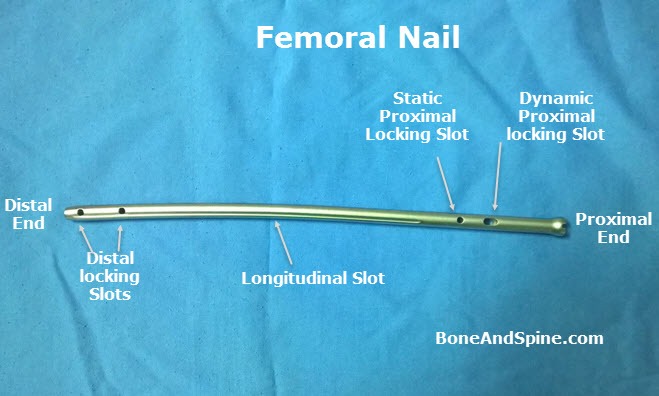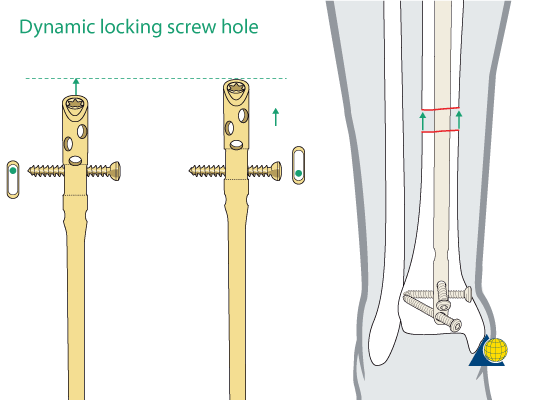Last Updated on May 28, 2019
What is Dynamization of nail?
Dynamization of nail is the process of converting a static interlock nail to dynamic nail by removing screw of the proximal static hole [read further for explanation].
Interlock nail is a common surgery in orthopedics. It is most commonly used for fracture of femur [read further for explanation]nd fracture of tibia.
Interlock nail is locked on both sides using screws leading to a static relation of bone and nail. There is no movement of the bone relative to nail. This kind of interlocking is called static locking.
Suppose now that the tibial nail is locked only at the distal end that fragment of the bone is fixed to nail. But the other end of the nail is not fixed to the bone. In this scenario, on weight bearing, distal fixed bone and nail move together towards knee but proximally only nail will move. The nail will just telescope through the proximal medulla till the fracture fragments are brought together.
This would repeat with every loading that occurs on walking.
This is an example of dynamic locking.
In actual practice, the nails are locked in the static mode because it provides better fixation, rotational control and better control over the fixed bone. However, it doesn’t allow the axial loading of the fracture.
Most of these fractures unite but some of these fractures are slow to unite and may not show enough union by 8-12 weeks. At this point, it may be worthwhile to convert this static mode into a dynamic mode so that fracture surfaces contact with loading and get a better chance of union.
Dynamization permits axial movements at the fracture site and is useful for fracture healing.
This process of conversion from static to dynamic mode interlock nailing is called dynamization of nail.
Dynamization of femoral nail and the tibial nail is commonly done because these are weight-bearing bones and predictable loading behavior can be expected.
How is Dynamization of Nail Done?
Nail dynamization is done by the removal of interlocking screw either proximal or distal to fracture site. It should be carried out only if the fracture is not showing signs of consolidation between 8-12 weeks. Som authors recommend it as long as 16 weeks after surgery.
AS we know that, there are two transverse screws slots on either end of the interlocking nail. Earlier, all the screw slots were circular and to dynamize both the screws were removed [or one if only one slot was used in the index surgery]. This provided dynamization but also left a fragment without any rotational control because there was no fixation to the bone on account of both screws being removed.
This could lead to rotational malalignment.
It was better if we could dynamize as well and retain the rotatory control.
This problem was solved by an oval slot for screws.
Modern nails have an oval slot or dynamic locking screw hole along with static locking screw hole or circular hole. See the image below. The nail used is a femoral nail.

When both the slots are filled by transverse screws, the nail is in static mode.
However, if we remove static locking screw or the screw from the circular slot, we get a dynamized nail which is fixed as well.
See the image below.
The dynamic screw is fixed on the bone on either cortex doe not allow rotation of the bone. At the same time, it also allows the nail to move with loading leading to desired dynamization.
Of course, the extent of dynamization is limited by oval slot length but then only a few mm of movement is required in most cases.

In a slow uniting fracture, the options are nail dynamization, exchange nailing, bone grafting and dynamic compression plate. Dynamization is a daycare procedure and very economical. It helps in increasing the contact area at the fracture site and improve osteogenesis.
Dynamization is argued not to change the union rate of the fracture but it does shorten the mean time to union.
What are the Risks or Disadvantages?
Dynamization is routinely not required. It is considered only for fractures which are healing slowly.
Spiral, long oblique and comminuted fracture are at risk of shortening by dynamization. The dynamization is more suited to transverse fractures.
Each case is different. The earliest time for the procedure is six weeks.
There is no known role of dynamization after 6 months.
It must be noted that not all cases achieve union after dynamization.
Procedure of Dynamization
The screw is removed under local anesthesia or regional anesthesia which may vary from person to person. C-arm image intensifier is used to locate the deep screws.
The procedure involves the removal of a single screw from the static locking hole.
After successful screw removal, the wound is closed. Nothing else is needed to be done on the procedure table.
Weight-bearing is begun immediately in local surgeries and after the effect of regional anesthesia is over.